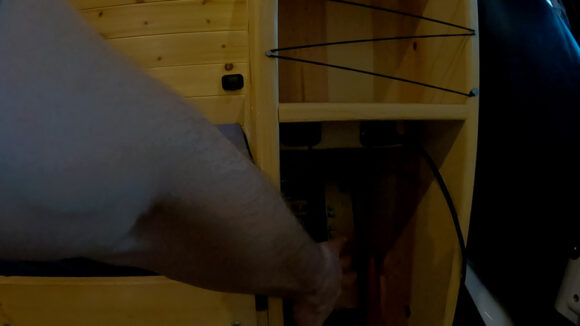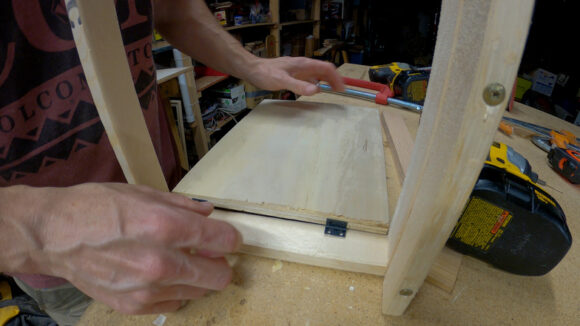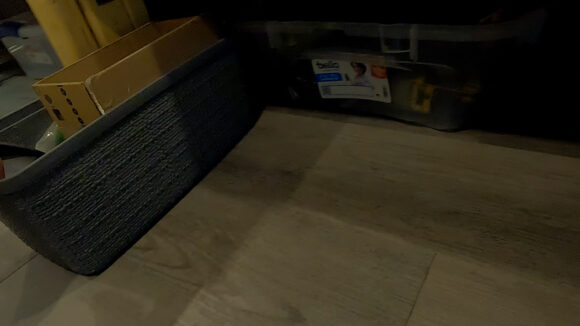Chevy Astro Camper Van Build: Shelving & Storage
Chevy Astro Camper Van Build Phase 12: Shelving & Storage
Tools & Materials
Materials:
Tool Box
Cargo Netting
Bungee Cords
Dimmer Switch For LED Puck Lights
12v DC Dimmer Switch
12v LED Light, Flush Mount
Shock Cord
Sikaflex 715
Wire Loom
Spax Construction Screws
Tools:
Dewalt Oscillating Tool
Dewalt Angle Grinder
Dewalt Orbital Sander
Dewalt Cordless Impact Driver
1/4″ Drive Quick Release Bit Extension
Wire Wheel Attachment
Air Tools
Craftsman Socket Set
Long Clamps For Woodworking
Hole Saw Kit
Speed Square
Video – Chevy Astro Camper Van Build: Shelving & Storage
Project Overview: Shelving & Storage
The main components of the van build are now done. I have insulation, flooring, walls and ceilings. The All of my electrical components are in place. I have a bed. Basically, all of the things I need to function are done. Now, it’s time to turn the rest of the available space into usage storage.
Shelving and storage in a camper van takes some thought. Making use of vertical space is probably the single most useful thing I can tell you about planning your shelving and storage layout. You need a place to store things, while not compromising floor space, if possible. The deeper your shelves are, the more interior space you lose. So it’s a compromise.
I chose to build shelves above my power center and behind my bed. Additionally, I’ll have plenty of storage under my bed. The shelving above the power center will be for my clothes, hiking gear, food, camera gear, toiletries etc. The shelves next to my bed will be for things like my glasses, remote control for media center, hat and various odds and ends that come and go in the cubby holes. The shelves between the bed and driver’s seat, that go floor to ceiling, will be for books, food and various things I want to keep close to me as I drive. The bottom section of the shelves will be open, to access the deeper space behind it, and taller. Here, I’ll keep my backpack that I store my laptop in.
Building the shelves, as well as all of the other woodworking projects in a camper van build, is much easier with a good workshop. I had access to a nice compound miter saw with sliding arm, table saw, belt sander, drill press, router… basically most things needed for woodworking. At a minimum, you need a table saw to rip long boards, and a miter saw (or circular saw) to do chop cuts. To make cuts that follow the contour lines of the van, it’s pretty necessary to have a jigsaw.
I highly recommend sanding the edges of all of your shelves down and rounding off the sharp corners. With sharp corners/edges, you WILL cut and nick your fingers, knuckles and hands from time to time as you reach into the shelves to grab something. It’s a nice touch to add extra comfort to your setup. I’ll be living in this camper van, so better make it comfortable.
Underneath the bed, I’ll store things like tools, towels, hiking and fishing gear, and a tray or two dedicated to my rock and mineral finds. I’ll use a series of open-top baskets/trays for this. It’s a bit of trial and error, buying a bunch of them from the store, and seeing which combination of bins fits the best for my space. Then, I just return the ones I didn’t use.
Build Shelves Above Power Center
First I start by cutting a 1×10 piece of select pine board for the vertical ends of the shelves. Because the wall is curved, I’ll need to trim off a bunch of wood along the ceiling and upper part of the boards. This takes at least 10 trips to my basement workshop and back to get right. I trim off a little at a time, mainly using a jigsaw. I’ve screwed down a board across the wall behind the shelving, and this provides a smooth surface for the vertical sides to butt up against, making the trimming somewhat easier as it follows a consistent curvature at the top.
I cut this funky piece (above) to fit around some wires on the ceiling. This piece gets screwed to the ceiling, and provides the horizontal surface for the vertical shelf ends to screw into.
The shelves are pretty basic. I made the bottom one tall enough to fit a 5 gallon bucket, since I’ll be carrying one often on my rock and mineral hunting adventures. I made the middle shelf tall enough to fit a box of Triscuits, and the top shelf gets whatever’s left. Spax construction screws of course, you know by now how much I love these. Notice the space I left on the end. I’ll use this for something else, later on.
Above you can see how I added another cedar plank to hide the ugly transition from ceiling to shelves. This (thankfully) doesn’t have to look too nice, since things on the shelf will hide most of this.
Build Shelving On Side Of Power Center
Like the other side of the power center, I decided to bring the sides in a bit from the ends of the power center. Especially here, where It’d be really nice to have some sort of storage space right here when I open the sliding side door to my van. So, I’ll build some cubby holes and shelves here. First, I need to build a frame. This gives me something to screw the vertical side boards to. Also, I’ll be mounting a swinging arm for my TV monitor here later, so I need this spot to be really sturdy. I use a 2×4 here for this, running vertically.
Next I cut a frame for the top shelving to sit on. Then, I cut the shelf that sits on top of the frame. You can see the odd shape of it in the photo above. Everything in a camper van build is a custom cut piece, like this.
Next I cut a board to mount my dimmer switch for the LED puck lights and battery monitor to. I fasten this to the side of my shelving and run my wires. I use an oscillating tool for the square hole, and a hole saw for the circular one.
After wiring up the dimmer switch and battery monitor, you can really see what a good location this is for these things. Right there when I open the sliding door on the van, which is how I always enter it. I add some trim pieces of wood along the edges of the vertical board, which turns the side shelving into a cubby hole of sorts. It will make a great place to store things that I use every day, and will need as I enter and exit the van… toothbrush and toothpaste, soap, hand wipes, watch, light, knife, etc. Additionally, I’ll use this space to lay my chargers and charging cables in while they are being charged or not being used.
Building Shelves Behind The Driver’s Seat
These shelves will go from floor to ceiling. They will only be as wide as the distance between my bed and the driver’s seat. Those who like to lean their seat way back won’t get much shelf space. A modest lean gives more storage space, so that’s what I go with. Again, I use select pine boards from home depot here. I use 48″ clamps to keep the boards together while I lined them up. I use the tall board in the back to keep the three side boards straight and aligned.
I fasten the boards together using spax construction screws. I know I’ll put some books in the top shelf, so I use them to make sure there’s enough vertical height for them.
Above, I’m laying the back piece for the shelves. I want the bottom part of the shelf to be taller, and not have a back to it. This will allow me to storage things deep in the cavity behind the shelves, under more shelves that I’ll build later, behind/above my bed.
When I try to put the shelves in the van, I realize they don’t fit. Well, the dimensions are right, but I forgot to account for the fact that I would need to turn/twist the shelves to fit them into the space I want them in. This can’t be done when the shelf has a width of 12″ or whatever, it can only be done when the shelf has no top and side pieces. So, I need to putt it out, disassemble it, and reassemble it in the van.
I’ve gotten the shelf in place and standing upright, and have put the top piece back on at this point. Now, I need to fasten the side board again, before I can slide the shelf into place behind my bed.
After reassembling the shelf, it slides into it’s place perfectly. You can see how the bottom is open, hopefully this makes sense now. I can easily access that “large” space for storage because the shelf has no back to it there.

The photo is dark, but it shows the two 12v outlets I wired in here at the top of the bottom opening. These plugs will power my fridge/cooler and my laptop
Sanding Edges Of Shelves
Sanding the edges of your shelves and woodworking inside the van is a nice touch to a camper van build. Don’t scoff at this. You will be living in this van for weeks and months on end, and every time you reach your hand into the shelf to grab something, you’ll appreciate the rounded corners over sharp, jagged edges and splinters. I use a belt sander and/or orbital sander to round the edges of my shelves.
Build The Shelves By My Bed
Now I’, left with a space behind my bed, between the backside of the shelves I just built and the wall. For this space, I plan to build another series of shelves for storage. The design is simple: I’ll build a frame out of 1x2s, screw them together, and slide/wedge it in place between the wall and shelves, the screw it to the backside of the shelves. I won’t screw it to the wall at all, so it will just be held by the screws on one side, along with the force of being wedges in-between the wall and shelves.
Above, I’m sliding the shelf’s frame into place. I’ll be able to add a support board below the frame on the wall here, because there is wood behind the wall here for support. But, not so higher up.
I want the bottom part of this shelf to open, so I can access the storage underneath, from my bed. At first, I use hinges, as shown above. However, these hinges are not going to hold up long-term. These are tiny screws biting into the side of plywood. It’s just not going to last.
Instead of the hinges, I use blocks of wood below the top part of the shelf for support. These blocks of wood allow the top part of the shelf to rest perfectly flush with the bottom of the shelving, and act as a stopper. I attached a thin piece of fabric to one side of the top piece, so all I need to do is pull this up to remove the top when needed. No hinges are necessary, the top just moves freely when needed.
Next, I build another similar frame and shelf system for the middle. This one, and the shelf above that, will have Flush Mount LED LIghts built in, to light up the cubby holes. Obviously I cant just drill through the bottom of the shelf itself to mount the light, so I build a mounting system that gives me a little clearance. A couple of scrap wood pieces accomplish this. I drill a hole in on, to mount the light through. Other wood pieces below this are cut to a half circle shape, making spacers behind the wood piece with the LED light in it. I route the wire through a hole drilled out the back of the shelving, which will run towards the backside of my driver’s seat.
Above, I install the dimmer switch for the LED lights in my shelves. The dimmer switch unit is square, so I had to cut a square-ish hole into a block of wood to mount the dimmer in/on. Then, I use drywall screws to fasten it to the wall.
Next I’ll cut a thin board to finish off the backside of the shelves, behind the driver’s seat. This wood becomes the back of the shelves I just built above my bed. I start by making a template out of cardboard, and transferring it to the board. I use a jigsaw to make the cut. This takes several attempts, taking a little off at a time, to ensure I don’t take too much off and ruin the board. Eventually, it slides into place for a fairly tight fit. You could use many things to secure this board, such as panel nails, tack nails or Wire Nails.
Above is a look at the shelves above the bed, complete. Because I hadn’t run wire behind the cedar plank for the simmer switch, I had to run my wire on top of the panel, a much less desirable solution. I made it look OK by wrapping it with some wire loom. Also notice the MaxxFan’s remote mounted here. I used a rubber/neoprene type material to line the bottom shelf with for grip. I also placed some little hooks on the underside of the middle shelf, to hang things from.
And finally, above you can see the bottom piece of my shelf and how it flips up to access storage underneath.
Netting For Shelving
So you’ve built yourself some shelves. But how do you keep stuff from falling out when you drive? Especially down rough dirt roads? Well, this is my solution; nails and Shock Cord. I used nails on the side faces of the shelves, and ran flexible shock cord in between them. This works really well. You can customize this setup to fit your needs… more or less tension, many rows of shock cord or only a few, or only running the shock cord across part of the opening (just the bottom half, for example). It sacrifices zero space from the shelves and costs very little. Shock cord has many great uses so I keep it around for other things too, especially my hiking gear.
For the larger shelves, above the power center, shock cord isn’t going to work. It works great for smaller spaces with less tension. For my largest, lower shelf, I’ll just use this Cargo Netting. This works great here, because many things I’ll put on this lower shelf (like clothes) actually stick out past the shelf itself, and the flexible cargo netting allows the storage space to essentially expand to fit your needs, within reason of course. The cargo netting came with a ton of these awesome plastic J-hooks, which I haven’t seen sold anywhere else expect through the manufacturer that makes the cargo netting (Organized Obie). Obie sells the J-Hooks for $1.05 each, with a minimum order of 10, and they don’t come with the screws. So when I rain out, I just bought some screw eyes instead, as these are cheap and easy to find anywhere. I used the J-Hooks and screw eyes to attach a bungee cord across the opening of the top two shelves. This provides enough surface area and tension to keep things in my shelves in place. I try to use bins, trays and boxes to store small items, instead of loosely placing them on the shelf. By Only placing bins and trays in the shelves, it’s easier to keep everything in place as well as organized.
Storage On Rear Side of Power Center Shelving
Above, you can see how I built the shelves in from the edge of the power center. So what will I do with this space? I use it to store taller, vertical items; fishing pole, ice axe, tent poles, etc. I also have a small garbage can attached here with a bungee. I store extra grocery bags here (for my garbage can), fishing reels, and a few other things.
Storage Under the Bed
The space under my bed is perfect for bins that can be slid underneath. The trick is finding the right combination of bin sizes for your space and needs. You can try to guesstimate while in the store, but ultimately, you’re better off just buying a bunch of various sizes and actually fitting them together under the bed. I just returned the ones I didn’t use.
You can see the wood blocks in the photo above. I made these out of oak, and had run a 1″ board in-between these blocks to keep the bins from sliding out from under the bed. However, after a month or so on the road, I realized the boards don’t really do anything for me, as the bins aren’t sliding around much, if ever, even under the worst of conditions. So I removed the boards, but kept the blocks, the blocks do sometimes catch the bins on the edge from sliding and keep them in place. There’s often enough tension between the bins themselves that that these blocks of wood on the outer edges are just enough provide a little help, while not being in the way at all. So, I just left them there, for now.
Previous Van Build Project: 11 – Power Center | DIY Stealth Camper Van Build Index | Next Van Build Project: 13 – Dometic Electric Cooler





















































Leave a Reply